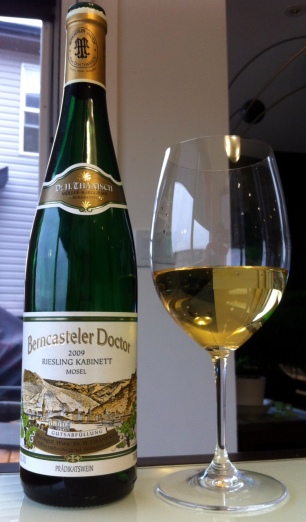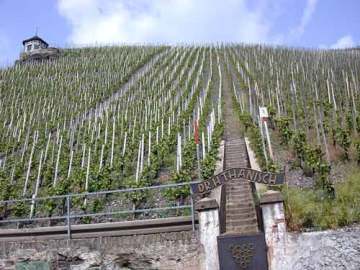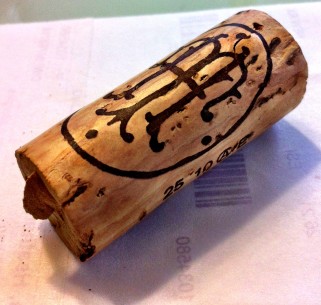Welcome to the second edition of Tasting In Stereo, a joint effort between yours truly and Tyler Philp of North of 9 Fine Wine that brings you two simultaneous reviews of tonight’s bottle, one immediately below on this page and the other over on the North of 9 blog. Once you’re done reading the PnP take on this wine, click on over to Tyler to see if he agreed or disagreed with my assessment…we do not share our thoughts or tasting notes with each other before publication, so I’m just as curious as you are to see if this bottle met Tyler’s fancy. For a bit of background about who Tyler is, how I met him and why we started up this simul-tasting endeavour, check out my inaugural Tasting In Stereo post here.

The one and only Bernkasteler Doctor...that's an actual rendition of the town of Bernkastel on the label with The Doctor rising up behind it.
Tonight’s Tasting In Stereo wine is right in my wheelhouse for a number of reasons. First, I’m pretty sure Tyler picked up his bottle the last time he was in Calgary, so we’re dealing with home turf inventory. Second, it’s a German Riesling, and if you know anything at all about me or about this blog, you’ll know that the way to my heart runs right through that grape and that country. Third, it’s not just any German Riesling: it’s a German Riesling from the Augusta (for those of you feeling like a golf analogy) of German Riesling vineyards, Bernkasteler Doctor. By way of quick review, if you look at the label of this or any German wine bottle, and you see two words in a row, the first of which ends in “er”, there is a 99% chance that the “er” word is the name of the village adjacent to the vineyard where the wine’s grapes were grown (with the possessive “er” added to signify that the vineyard is “from” that village) and the following word is the name of the vineyard — this is my Two Word “Er” Rule for deciphering German wine labels. In this case, the relevant village is Bernkastel, which is in the heart of Germany’s Mosel Valley (don’t ask me why the label spells “Berncasteler” with a C instead of a K…even the neck label of this same bottle spells “Bernkastel” with a K like I’m used to seeing) and the vineyard’s name is Doctor. Why Doctor, you ask? Cue the best back story any plot of dirt could ever want…

The Doctor vineyard in real life...imagine trying to stay upright while walking that, let alone trying to harvest it!
As legend has it, back in the 13th century a powerful Archbishop was in the Bernkastel area when he fell very ill. All of the most respected medicines and cures of the day did nothing to restore his health, and he got worse and worse. Finally, on his deathbed, he was given a glass of Riesling made from grapes grown in the local vineyard. His condition almost immediately improved and he was shortly back to full health, which he credited to the product of the vineyard he dubbed “The Doctor”. Today, while Rieslings from Bernkasteler Doctor aren’t considered cure-alls, the Doctor vineyard is arguably the best vineyard in Germany, and it is certainly the most famous. Almost impossibly steep, it looms over the town of Bernkastel at a dizzying angle, forcing all harvesting to be done by hand (as machines would literally just tumble down the slope) but exposing as much of each grapevine to the sun as possible. The vineyard’s slope is west-facing, perfectly situated to catch the afternoon sun, and it is immediately adjacent to the Mosel River, which helps moderate temperature. The vines planted on the Doctor are nearly a century old and produce wines that, at their best, are the foremost expression of German Riesling in the world. Until tonight, I had never tried a wine from B. Doctor. Suffice to say I was ready to be cured.
The first thing I noticed when the wine hit my glass was that it was completely still — there were no CO2 bubbles as sometimes found in German Rieslings when producers dose the wine with carbon dioxide on the bottling line to keep it fresh and lively. The Thanisch was a classic Kabinett Riesling pale straw colour, with touches of bright gold at the edges possibly hinting at some additional fullness or depth in the wine. The nose didn’t feature the instant aromatic assault that I’ve come to expect from my favourite grape; while it was instantly recognizable as German Riesling, it came across as a little more subdued than most of its brethren. There was still a great mix of aromas, tropical fruits like pineapple and mango giving way to floral notes and Riesling-y smells like wet pavement and burnt matches, but everything was lower on the volume dial than usual. Perhaps this was simply a decoy to lull me into a false sense of security before my first sip, because the intensity of flavour that was muted on the nose exploded all at once like a vinous landmine as soon as the wine touched my tongue. The Doctor was much more lush and ripe than most Mosel Rieslings, showing peach, nectarine and Asian pear notes instead of the apple and lemon more common to this cooler climate. The hallmark Germanic gasoline/petrol flavour shone through this bright sweet fruit along with honey, rocks and a slight hint of grassiness, all presented in a fuller, more rounded way than I was used to seeing in a Kabinett Riesling. There was clearly a fair amount of residual sugar present (only 9.5% alcohol, which means the fermentation was stopped with sugar still left in the wine), and you can taste it throughout, but it never falls out of balance and the wine still finishes dry, mineral and almost tart thanks to searingly high levels of balancing acidity.
The Thanisch is certainly delicious, and it showcases a flavour profile of grape and place that I never tire of, but it doesn’t really elevate itself to that mind-warping level that I was expecting from Germany’s top vineyard, a spot that is quite possibly THE place for Riesling on planet Earth. At a shade over $40, this is probably the cheapest bottle you’re going to find from Bernkasteler Doctor, and as such it’s well worth the purchase just for the chance to taste wine from such a historic locale, but when you open a bottle expecting to be wowed, anything less than that just ends up feeling like a consolation prize. Maybe Tyler, less burdened by Teutonic anticipation, will be able to be a little more objective, but for me, this is a super solid bottle of wine that doesn’t quite distinguish itself in the way that its birthright suggests it should. Over to you, Tyler!
89- points
$40 to $45 CDN



Leave a comment